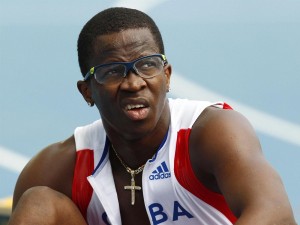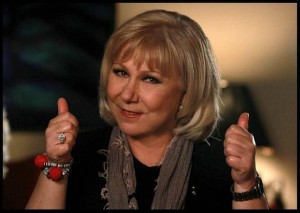In the syncretism Shango is compared to Santa Barbara and has its feast celebration on December 4, according to the Calendar of saints of the Catholic church.
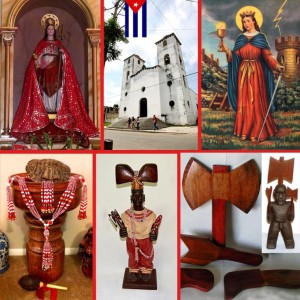
Santa Barbara was a Christian virgin and martyr of the third century, is part of the official list of the martyrdom of the Catholic Church and on schedule or Catholic calendar his feast is celebrated on December 4.
Is usually represented him well with the palm of martyrdom or with peacock feathers, because this animal is a symbol of resurrection and immortality, and appears already in the oldest known representation, dating from the eighth century Santa María la Antigua , Rome.
In the best known in our country image often appears with his attribute: a tower with three windows and elsewhere, the tower appears beside or thumbnail on one hand. The meaning of this tower with three windows is the refuge of faith in the Holy Trinity. It usually takes crown, which supports variations: in some it is a princess and other is a full crown formed of several towers.
The image of Santa Barbara also appears sometimes associated with the sword with which he was beheaded, which contributed to it being associated with war, but this sword is a symbol of unwavering faith and a chalice, which means its conversion to Catholicism.
The lightning hit their martyrdom has made it related to explosives and so is patron of artillery gun, whose shield are crossed cannons and the tower is the heraldry of engineers and sappers. Explosives in tank ships Santabárbara called.
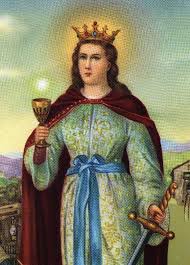
Sometimes carries an olive branch in his hands, representing the martyrdom. But always with his red cloak, chalice with the blood of Christ.
She is the patron of professions handling explosives, due to the legend of lightning, and especially the military that belong to artillery gun in most armies, even in some Muslim countries. In the Asturian coalfields dedicate a song called “Santa Barbara blessed” to be patron saint of miners. He is also the patron saint of electricians. It is also the patron saint of merchants. Is classic patronage exercised in raised beds. So in some iconography your figure next to boulders. It is also patron of architects.
In Cuba the popular church of Santa Barbara is located in the neighborhood of Parraga, municipality of Arroyo Naranjo. There are not only faithful Catholic, but also frequented by devotees of Shango, the Yoruba religion.
Chango or Shango (in Yoruba, Sango) is a god of the Yoruba religion. You Shango syncretism compared to Santa Barbara, which has its party on December 4, according to the Catholic calendar calendar. Your day is Saturday, although Friday is also popular. Their number is 6 and its multiples, although some is teamed with four, perhaps because of its religious syncretism with Santa Barbara. Their colors are red and white and her necklace is also account for that color. Kao greet Kabiesilé, Shango Alufina!
Shango is one of the most popular Orishas of the Yoruba pantheon. It is considered Orisha of thunder, lightning, justice, virility, dance and fire. Osha Shango is a warrior, king of the Yoruba religion and one of the most popular Orishas of their pantheon. Shango is an Osha and is in the group header Oshas. Orisha of justice, dance, manly strength, thunder, lightning and fire, owner of the Bata drums, wemileres, Ilú Batá or bembes, dance and music; represents the need and joy of life, the intensity of life, male beauty, passion, intelligence and wealth. It owns the religious system of Osha-Ifa.
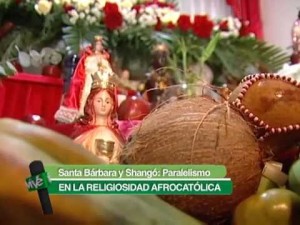
Orisha of justice, dance and manly strength, owner of the Bata drums, wemileres, Ilú Batá or bembes, dance and music; represents the need and joy of life, the intensity of life, male beauty, passion, intelligence and wealth.
A Shango is offering Amala made from cornmeal, milk and okra, green bananas, OTI, Indian banana, red wine, roasted corn, barley, canary seed, etc. He immolated rams, cocks, quails, jicotea (river turtle), guinea fowl, pigeons, etc. His ewe are punctured damn, atiponlá, platanillo of Cuba, Ceiba, paradise, cedar, poplar, Baria sarsaparilla, carey vine, red vine, seedling, camagua, cimarrona combustera, sugarcane, onion, mahogany, flamboyant, white guano , guano prieto, laurel, corn, bat bitter, red mamey, post boma, jicotea grass, pinion, physic nut, okra, rompesaragüey, rue, tomato, transverse, yaya, palm, peony, mint, clover, canistel, filigree, yaba and others.
Cuba Memory/Derubín Jacomé / InternetPhotos / www.thecubanhistory.com
The Cuban History, Hollywood.
Arnoldo Varona, Editor.
CUBA PHOTOS.
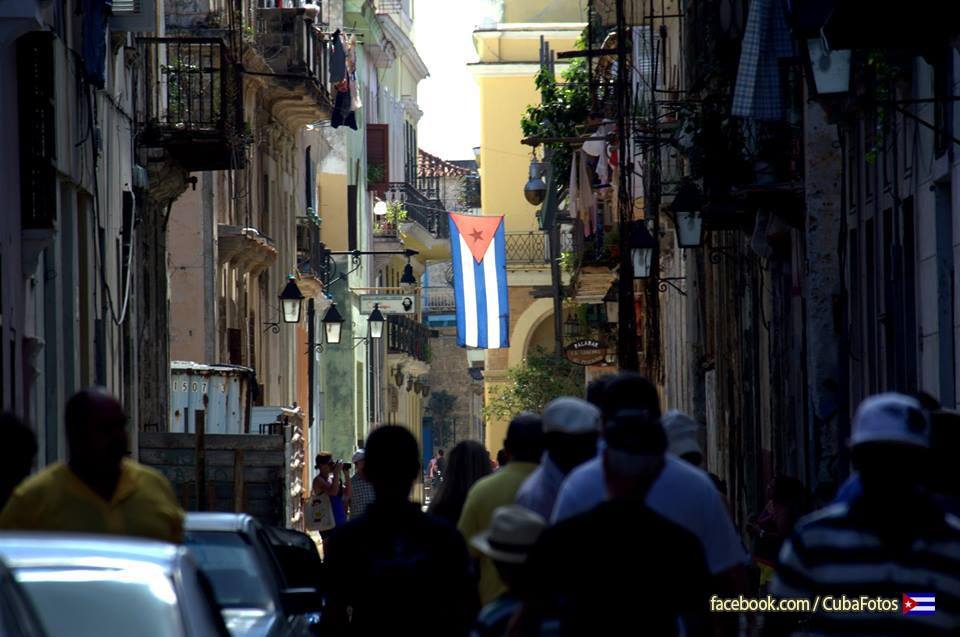
CUBA Y SU SANTA BARBARA BENDITA.
Shangó en el sincretismo se compara con Santa Bárbara y también tiene su fiesta el 4 de Diciembre, según al calendario santoral católico.
Santa Bárbara fue una virgen y mártir cristiana del siglo III, forma parte de la lista oficial del martirologio de la Iglesia Católica y según el calendario o santoral católico su fiesta se celebra el 4 de diciembre.
Se le suele representar bien con la palma del martirio o bien con plumas de pavo real, pues este animal es símbolo de la resurrección o la inmortalidad, y aparece ya en la más antigua representación conocida, que data del siglo VIII en Santa María la Antigua, de Roma.
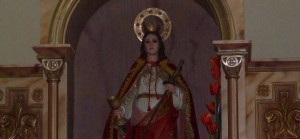
En la imagen más conocida en nuestro país suele aparecer con su atributo: una torre con tres ventanas y en otras, la torre aparece a su lado o en miniatura sobre una de sus manos. El significado de esta torre con tres ventanas es el refugio de la fe en la Santísima Trinidad. Suele llevar corona, que admite variaciones: en algunas es la de una princesa y en otras es una corona completa formada de varias torres.
La imagen de santa Bárbara también aparece a veces asociada con la espada con la cual fue decapitada, lo que ha contribuido a que sea asociada con la guerra, pero dicha espada representa un símbolo de fe inquebrantable y con un cáliz, que significa su conversión al catolicismo.
El rayo que cayó en su martirio ha hecho que sea relacionada con los explosivos y así es patrona del arma de artillería, cuyo escudo son cañones cruzados y la torre es la heráldica de los ingenieros y zapadores. El depósito de explosivos en los buques recibe el nombre de Santabárbara.
En ocasiones lleva una rama de olivo entre sus manos, representando el martirio. Pero siempre con su manto rojo, cáliz de la sangre de Cristo.
Es la patrona de las profesiones que manejan explosivos, debido a la leyenda del rayo, y especialmente de los militares que pertenecen al arma de artillería en la mayoría de los ejércitos, incluso en algunos países musulmanes. En las cuencas mineras asturianas le dedican un himno llamado “Santa Bárbara bendita”, por ser patrona de los mineros. También es la patrona de los electricistas. Igualmente es la patrona de los feriantes. Es clásico el patronazgo que ejerce de los canteros. Por ello en alguna iconografía aparece su figura junto a bloques de piedra. Es patrona también de los arquitectos.
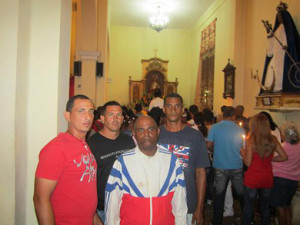
En Cuba la popular iglesia de Santa Bárbara se encuentra en el barrio de Párraga, municipio de Arroyo Naranjo. Allí no solamente van sus fieles de religión católica, sino también frecuentan los devotos de Shangó, de la religión yoruba.
Changó o Shangó (en yoruba, Ṣàngó ) es un dios de la religión yoruba. Shangó en el sincretismo se compara con Santa Bárbara, la cual tiene su fiesta el 4 de Diciembre, de acuerdo al calendario santoral católico. Su día de la semana es el sábado, aunque el viernes también es popular. Su número es el 6 y sus múltiplos, aunque algunos le adjudican el 4, quizás por su sincretismo religioso con Santa Bárbara. Sus colores son el rojo y blanco y su collar también es de cuentas de ese color. Se saluda ¡Kaó Kabiesilé, Shango Alufina!
Shangó es uno de los más populares Orishas del panteón Yoruba. Es considerado Orisha de los truenos, los rayos, la justicia, la virilidad, la danza y el fuego. Shango es un Osha guerrero, el rey de la religión Yoruba y uno de los Orishas más populares de su panteón. Shango es un Osha y está en el grupo de los Oshas de cabecera. Orisha de la justicia, la danza, la fuerza viril, los truenos, los rayos y el fuego, dueño de los tambores Batá, Wemileres, Ilú Batá o Bembés, del baile y la música; representa la necesidad y la alegría de vivir, la intensidad de la vida, la belleza masculina, la pasión, la inteligencia y las riquezas. Es el dueño del sistema religioso de Osha-Ifá.

Orisha de la justicia, la danza y la fuerza viril, dueño de los tambores Batá, Wemileres, Ilú Batá o Bembés, del baile y la música; representa la necesidad y la alegría de vivir, la intensidad de la vida, la belleza masculina, la pasión, la inteligencia y las riquezas.
A Shangó se le ofrenda amalá hecha a base de harina de maíz, leche y quimbombó, plátanos verdes, otí, plátano indio, vino tinto, maíz tostado, cebada, alpiste, etc. Se le inmolan carneros, gallos, codornices, jicotea (tortuga de río), gallina de guinea, palomas, etc. Sus ewe son el bledo punzó, atiponlá, platanillo de Cuba, Ceiba, paraíso, cedro, álamo, baría, zarzaparilla, bejuco carey, bejuco colorado, almácigo, camagua, combustera cimarrona, caña de azúcar, cebolla, caoba, flamboyán, guano blanco, guano prieto, laurel, maíz, palo amargo, mamey colorado, palo boma, hierba jicotea, piñón, piñón botija, quimbombó, rompesaragüey, ruda, tomate, travesera, yaya, palma, peonía, hierbabuena, trébol, canistel, filigrama, yaba y otros.
Memoria de Cuba/Derubín Jacomé/InternetPhotos/www.thecubanhistory.com
The Cuban History, Hollywood.
Arnoldo Varona, Editor.




